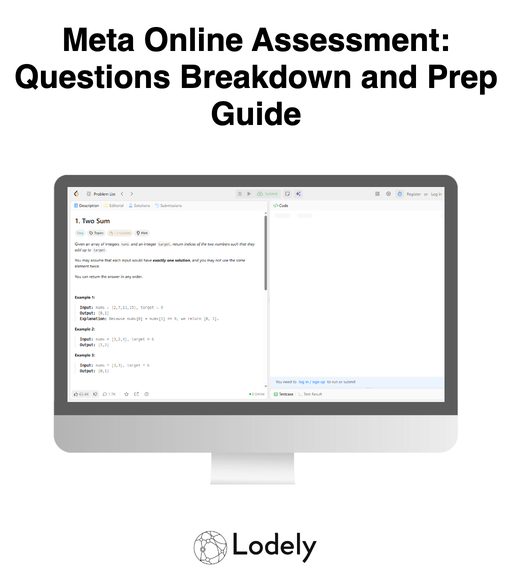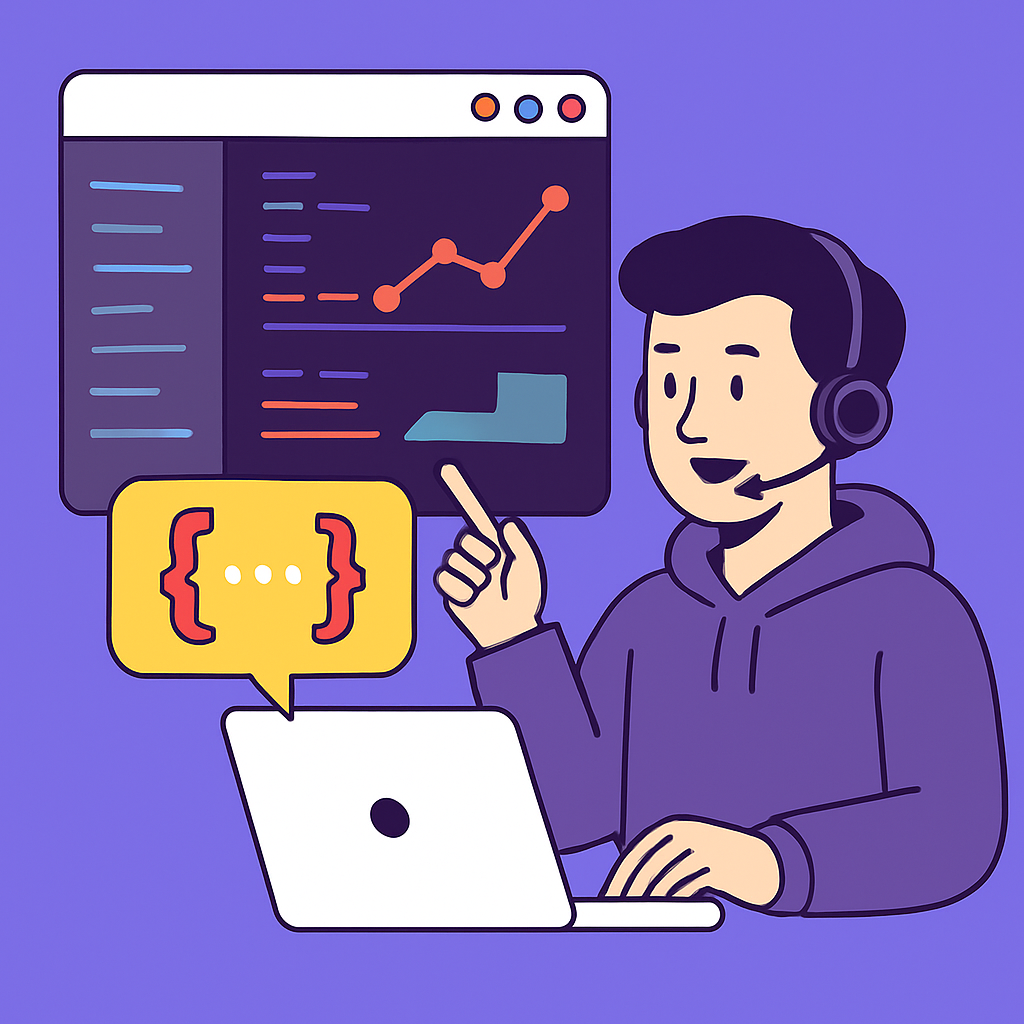Meta Online Assessment: Questions Breakdown and Prep Guide
Thinking about “Cracking Meta’s Assessment” but not sure what you’re getting into? You’re not alone. Engineers across the world are staring down HackerRank, CodeSignal, time pressure, and product-flavored puzzles — and sometimes the hardest thing is knowing which challenge to train for.
If you want to walk into the Meta Online Assessment (OA) confident, prepared, and ready to knock it out of the park, this guide is your playbook. No fluff. Real breakdowns. Strategic prep.
When to Expect the OA for Your Role
Meta doesn’t send the exact same OA to everyone. The timing and content depend on your role, location, and level.
- New Grad & Intern Positions – Very common. Expect an OA link from HackerRank or CodeSignal within 1–2 weeks of recruiter contact. For many interns, it’s the primary technical filter before final rounds.
- Software Engineer (Backend / Full-Stack / iOS / Android) – Standard practice. Expect 1–2 coding problems in 70–90 minutes. Questions are algorithm-heavy with practical edge cases.
- Production Engineering / SRE / Infra – OA may include systems-oriented coding tasks (log parsing, rate limiting, resource scheduling).
- Data Engineering / Analytics Engineering – Sometimes an OA with basic algorithms plus SQL-style or ETL reasoning. Confirm with your recruiter.
- Senior Roles – Sometimes skip a generic OA and move straight to live coding/design, but many senior candidates still see a short OA to calibrate.
Action step: As soon as you get a recruiter email, ask “What’s the expected format of the OA for this role?” Recruiters will usually share platform, duration, languages allowed, and number of questions. If there’s a debugging section, they’ll often tell you.
Does Your Online Assessment Matter?
Short answer: yes — and more than you might think.
- It’s the main filter. A strong resume might get you an invite, but your OA performance determines whether you see an interview loop.
- It sets the tone. Your OA code can be reviewed by later interviewers and shape the questions you get.
- It’s realistic. Meta’s OA tends to mimic product-scale conditions: streaming data, ranking/aggregation, graph traversal over large friend networks.
- It signals your engineering habits. Readability, testability, and edge-case handling matter — not just passing happy-path tests.
Pro Tip: Treat the OA like a “first impression interview.” Time yourself, write clean code with intent-revealing names, and explicitly handle edge cases.
Compiled List of Meta OA Question Types
Candidates report seeing the following categories in Meta assessments. Practice these:
- Friend Suggestion via Mutual Connections — type: Graph / Counting (also see “number of common neighbors” patterns)
- Merge K Sorted Streams — type: Heap / Divide & Conquer
- Top K Frequent Elements — type: Heap / Hash Map
- Course Schedule (Detect Cycle) — type: Graph / Topological Sort
- Word Ladder — type: Graph / BFS
- Minimum Window Substring — type: Sliding Window / Hash Map
- Subarray Sum Equals K — type: Prefix Sum / Hash Map
- LRU Cache — type: Design / LinkedHashMap pattern
- Clone Graph — type: Graph / BFS-DFS
- Binary Tree Right Side View — type: Tree / BFS
- Meeting Rooms II — type: Intervals / Heap
- Task Scheduler — type: Greedy / Counting
- Insert Delete GetRandom O(1) — type: Hashing / Array
- Find All Anagrams in a String — type: Sliding Window
- Rotting Oranges — type: Grid / BFS
- Median of Two Sorted Arrays — type: Binary Search / Partition
How to Prepare and Pass the Meta Online Assessment
Think of your prep as a mini training camp. You’re not just memorizing solutions; you’re building reflexes.
1. Assess Your Starting Point (Week 1)
List what you’re strong in (arrays, hashing, strings) and where you hesitate (graphs, heaps, DP). Use LeetCode Explore or CodeSignal practice tests to benchmark. A quick mock OA under time pressure will expose pacing gaps and edge-case blind spots.
2. Pick a Structured Learning Path (Weeks 2-6)
You have options:
- Self-study on LeetCode/HackerRank
- Best for disciplined learners who can build topic lists and stick to timers.
- Mock assessments / bootcamps
- Paid platforms simulate Meta-style OAs with proctoring and stricter timing.
- Career coach or mentor
- A software engineer career coach can help you clean up code structure and think out loud under time pressure.
3. Practice With Realistic Problems (Weeks 3-8)
Don’t grind random easy problems. Build a curated list of 40–60 Meta-style questions: sliding window, hash maps, heaps, BFS/DFS on graphs, and interval scheduling. Timebox to 25–35 minutes per medium and 40–50 minutes per hard. After solving, refactor for clarity and test additional edge cases.
4. Learn Meta-Specific Patterns
Meta favors practical, product-adjacent patterns. Expect:
- News Feed aggregation
- Merge sorted streams, rank by score/time, keep top K with a heap.
- Social graph traversal
- BFS/DFS for shortest connections, friend-of-friend counts, or reachability.
- Rate limiting / event windows
- Sliding window with queues or deques; careful off-by-one handling.
- Caching and consistency
- LRU/LFU-style design questions with tight complexity requirements.
5. Simulate the OA Environment
Recreate the test: 70–90 minutes, 1–2 problems, camera/mic off distractions. Practice on HackerRank or CodeSignal. Use the same language and standard library functions you’ll use on the real thing. Get comfortable writing your own small helpers fast (heap wrappers, counter maps, input parsing).
6. Get Feedback and Iterate
Post solutions for review, or re-review a day later. Track repeated issues (indexing errors, boundary checks, missing null cases). Maintain a “mistakes log” and build mini-drills to eliminate those patterns.
Meta Interview Question Breakdown

Here are featured sample problems inspired by Meta’s OA flavor. Practice these to cover the bulk of Meta’s assessment surface area.
1. Friend Suggestions via Mutual Connections
- Type: Graph / Counting
- Prompt: Given an undirected graph representing friendships and a target user u, suggest K new friends by ranking non-friends of u by the number of mutual connections with u. Break ties by user ID.
- Trick: Precompute the neighbor set for u, iterate over neighbors’ neighbors, skip u and current friends, and count with a hash map. Return top K using a heap.
- What It Tests: Efficient graph neighborhood traversal, hash maps, and heap-based ranking with clean tie-breaking.
2. Merge K Sorted News Feed Streams
- Type: Heap / Merge
- Prompt: You’re given K sorted lists of posts (each with timestamp and score). Merge into a single feed sorted by descending score (then by recency).
- Trick: Use a min-heap or max-heap with a comparator (score, timestamp). Push the head of each list, pop/push next from that list. Avoid O(nk) sequential merges.
- What It Tests: Priority queues, comparator logic, and careful handling of composite sort keys.
3. Sliding Window Rate Limiter
- Type: Sliding Window / Queue
- Prompt: Implement an API rate limiter that allows at most N events per rolling window of W seconds. Given a stream of timestamps, return whether each event is allowed.
- Trick: Maintain a deque of timestamps. For each incoming t, pop from the front while t - front >= W, then check size < N before admitting.
- What It Tests: Real-world streaming pattern, off-by-one/time boundary precision, O(1)-amortized updates.
4. Content Moderation Rule Evaluator
- Type: Parsing / Stack
- Prompt: Evaluate boolean expressions over post attributes (e.g., "(spam AND NOT high_reputation) OR flagged") given a dictionary of attribute booleans.
- Trick: Convert infix to postfix via the shunting-yard algorithm, then evaluate with a stack. Correctly handle precedence and NOT binding.
- What It Tests: Expression parsing, stack discipline, and meticulous correctness under precedence/parentheses.
5. Top K Trending Hashtags
- Type: Heap / Hash Map / Streaming
- Prompt: Given a stream of strings (hashtags), continuously return the top K most frequent so far. Support updates in near real-time.
- Trick: Maintain counts in a hash map; track current top K with a min-heap of size K. On updates, adjust heap membership lazily with a validity check.
- What It Tests: Streaming frequency counting, heap operations, and trade-offs between exactness and speed.
What Comes After the Online Assessment

Passing the Meta OA isn’t the finish line — it’s the entry ticket. After you clear it, the process shifts from “can you code under pressure” to “can you build, reason, and collaborate at scale.”
1. Recruiter Debrief & Scheduling
If you pass, expect an email within a few days. You’ll get timelines and an outline of upcoming rounds. Ask about interview structure (number of coding vs. design rounds), language preferences, and any focus areas relevant to the team.
2. Live Technical Interviews
You’ll code with one or two engineers in a shared editor (often CoderPad or a similar tool). Expect:
- Algorithms & Data Structures similar to OA but interactive
- Follow-ups on complexity and edge cases
- Occasional “fix a broken function” or “extend your solution” prompts
Pro tip: Review your OA solutions. Interviewers sometimes ask you to walk through them or improve them.
3. System Design / Architecture Round
For mid-level and senior roles, a 45–60 minute design interview is common. Prompts might include:
- Designing a news feed or timeline service
- Messaging fan-out and delivery guarantees
- A rate-limited, cached read-heavy service
They’re evaluating decomposition, scaling, data models, consistency/availability trade-offs, and failure handling.
4. Behavioral & Values Interviews
Meta emphasizes impact, velocity, and collaboration. Expect prompts like:
- “Tell me about a time you moved fast under ambiguity.”
- “Describe a trade-off you made that improved impact.”
- “How did you influence a decision without authority?”
Use STAR formatting, quantify outcomes, and highlight ownership and cross-team collaboration.
5. Final Round / Onsite Loop
Often a half-day set of back-to-back sessions:
- One or two coding interviews
- One design interview (level-dependent)
- Behavioral or cross-functional conversations
Manage your energy: hydrate, take brief reset moments between rounds, and clarify requirements before coding.
6. Offer & Negotiation
If you pass, you’ll get a verbal followed by a written offer. Meta comp often includes base, bonus target, and equity. Do market research, ask about level calibration, and negotiate thoughtfully across cash and equity.
Conclusion
You don’t need to guess. You need to prepare. The Meta OA is tough but predictable. If you:
- Identify your weak areas early,
- Drill Meta-style problems with timers,
- Write clean, testable code and handle tricky edges,
you’ll turn the OA from a hurdle into momentum. Product context helps, but disciplined problem-solving is what carries you. Treat the OA as your first interview, not just a test, and you’ll set yourself up for a stronger loop and a better shot at the offer.
For more practical insights and prep strategies, explore the Lodely Blog or start from Lodely’s homepage to find guides and career resources tailored to software engineers.





%2C%20Color%3DOriginal.png)



